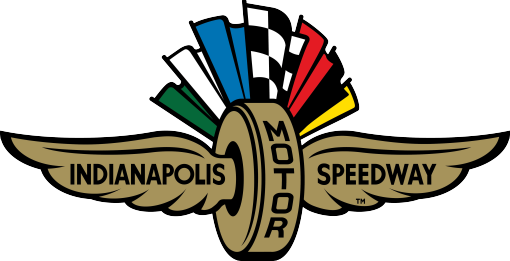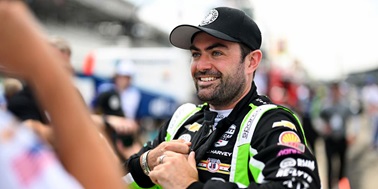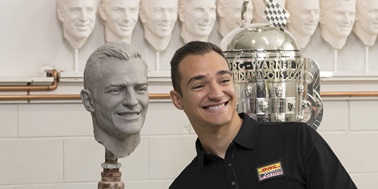1950
Rain put a premature end to the 1950 race, the checkered flag being waved at 345 miles when a storm moved through.
The legend persists to this day that the crew of winner Johnnie Parsons had discovered a crack in the engine block on race morning and that team strategy had been modified to try and pile up as much lap-prize money as possible before the inevitable failure. In fact, the beads on condensation they had noticed were determined to have seeped up through porosity in the metal and, once a couple of mechanics had gently peened either side of the block with mallets, the problem was solved. Not only did it hold up, but the same block was still on the Offenhauser engine when Mike Nazaruk would drive it the entire 500 miles to second place the following year.
Hardly anybody could believe it during qualifications when “rookie” Walt Faulkner went out and won the pole position at the very last second. Driving J. C. Agagjanian’s dirt car, Faulkner turned a single lap of 136.013 mph and registered a four-lap average of 134.343 mph to break the records set four years earlier by the late Ralph Hepburn, who had driven a front-drive supercharged Novi.
1951
Forty-year-old Lee Wallard, an East Coast sprint car driver who once operated a bulldozer in order to make a living during the off-season, scored one of the most popular victories ever.
One of the comparatively few drivers to lead both the first lap and the last lap of the same race, Wallard was in front for 159 of the 200 laps in spite of his lightweight dirt track–type car giving him a most uncomfortable ride.
The exhaust pipe came adrift, his brakes failed with 12 laps to go and his right rear shock absorber broke, thus giving him a terrible pounding over the bricks and mortar. Severely chafed skin, caused by the abrasive material of his crudely fireproofed uniform, required post-race medical attention, during which time it was discovered he shed more than 12 pounds since breakfast.
It was a race of great attrition, only eight cars being around at the finish and not one of the 25 eliminated having been involved in an incident involving more than one car.
1952
It was one dramatic moment after another. First, Freddie Agabashian caused a major upset by winning the pole position, driving a low-slung car powered by a Columbus, Indiana–built 401-cubic-inch Cummins Diesel truck engine, laid on its side and boosted by the track’s first-ever turbocharger.
Next, veteran Chet Miller nearly recorded the first-ever 140-mph lap, turning 139.600 mph in one of the very popular V-8 Novis.
Bill Vukovich led for almost three quarters of the race with the first of the Kurtis–Kraft “roadsters,” so nicknamed because of their resemblance to a street-going sports car. When Vukovich stopped with a steering arm failure only eight laps from the finish, into the lead swept J. C. Agajanian’s dirt-track car, driven by six-foot, two-inch, 245-pound Troy Ruttman. At 22 years, one month and 19 days of age, he was the “500’s” youngest winner ever.
1953
Nineteen fifty-three will be forever remembered as a year of sweltering, oppressive heat and an abundance of relief drivers.
Some cars were shared by as many as three different drivers as temperatures soared into the mid-90s and the bricks on the main straight registered up to 130 degrees by mid-afternoon. But Fresno, California’s Bill Vukovich became known as “The Iron Man” as he went it alone and utterly dominated the race. He started on the pole and led all but five laps, surrendering the lead only while making his first of three pit stops.
1954
For the second year in a row, sweltering heat resulted in an unusually high number of relief drivers—the 11th-placed finisher used five—and for the second year in a row it was the same driver who won.
He was Bill Vukovich, “The Iron Man” from Fresno, Calif. who didn’t use a relief driver. No less tough was Arizona’s Jimmy Bryan, who took second in spite of a terrible pounding caused by the failure of the right rear shock absorber on his dirt-track car with 60 laps to go. Third-placed Jack McGrath set new track records during qualifications and was the first to exceed 140 mph, his fastest lap being 141.287 mph.
1955
The 1955 race unfortunately will forever be remembered not so much for the fine victory by Bob Sweikert, but rather for it being the race in which defending two-time winner Bill Vukovich lost his life.
Vukovich was on his 57th lap and leading when he became entangled in a multi-car accident which had developed on the backstretch directly in front of him. Striving for an unprecedented three in a row, he had seemingly been assured of it only moments before when Jack McGrath, his closest rival, had dropped out with mechanical problems.
A little-known story concerning the dynamic Sweikert was that due to chief mechanic A.J. Watson having been called back to California when his wife lost a baby, it was Sweikert who single-handedly tore down the Offenhauser engine after qualifying and prepped it for the race.
1956
More than 600 yards of bricks were still exposed on the main straight, but the rest of the track had been completely resurfaced, resulting in lap speeds being faster than ever.
Pole winner Pat Flaherty set new qualifying records and raised the single-lap mark to 146.056 mph. Dressed only in slacks and a T-shirt, Flaherty also won the race, delighting the crowd by dirt-tracking through the turns with such verve that the front left wheel would routinely lift three or four inches from the surface.
The fact that the race could even start on time was due to what became known as “Cagle’s Miracle.” So much rain fell during the days leading up to the race that the infield creek broke its bank and all of the tunnels flooded. Grounds Superintendent Clarence Cagle stayed up for 48 straight hours supervising the pumping-out and drying-up process, which was completed with just minutes to spare.
1957
It is inconceivable that a man could design and build a revolutionary car in a garage next to a home in California, go into debt in the process, tow it to Indianapolis on borrowed money and end up winning the "500." But that is precisely what occurred in 1957.
George Salih, chief mechanic on Lee Wallard's winning car in 1951 and a plant manager at Meyer & Drake (producers of the Offenhauser racing engine), had long envisioned a low-sitting car in which a four-cylinder "Offy" could be placed on its side in order to achieve a lower center of gravity. Unable to interest any potential owner in the project, Whittier resident Salih went ahead and built the car himself, aided by his friend Howard Gilbert, later A.J. Foyt's engine builder.
Even after Sam Hanks (second with Salih in 1956) had qualified the car, Salih was still trying to secure a purchaser. Unable to do so, he went ahead as a very reluctant car owner and, unbelievably, won the race. Hanks retired, Salih changed his mind about selling, and in 1958, Jimmy Bryan drove the little car to a second win.
1958
Unfortunately, the 1958 “500” will be remembered for a huge multi-car accident in turn three of the opening lap, which took the life of the very popular Pat O’Connor.
The race was won by close friend of O’Connor’s, Jimmy Bryan, the three-time National Champion from Phoenix, Ariz., who drove the very same car which had carried Sam Hanks to Victory Lane the year before. Designed to carry an Offenhauser engine laid over on its side in order to obtain a lower center of gravity, mechanic George Salih had built it in the garage next to his home in Whittier, California, then reluctantly had to campaign it himself because he was unable to find a buyer.
There were several additional “sidewinders” in the 1958 race, impressive “rookie” George Amick taking second in one of them only 27 seconds behind Bryan. Another “rookie,” but one who didn’t finish, was 23-year-old A.J. Foyt of Houston, Texas. He would end up qualifying for the “500” an amazing 35 years in a row, a record likely to stand forever.
1959
This was the year of the “Flying W’s”, namely Watson, Ward and Wilke.
Two-time “500”-winning chief mechanic A.J. Watson had teamed up with longtime racing benefactor Bob Wilke for the purpose of building cars for other people in addition to entering their own. In spite of never having finished higher than eighth in any of his eight previous 500 starts, their driver, Rodger Ward, charged from sixth to second on the first lap and then led 130 of the 200 laps on the way to forcing Jim Rathmann into the runner-up position for the third time since 1952.
Rathmann, whose car was a twin sister to Ward’s, was originally to have been a teammate until Wilke agreed to sell the car to Lindsey Hopkins, for whom Rathmann had been driving since 1956.
Although later builders were credited with having pioneered pneumatic onboard air jacks for expediting pit stops, it was in reality Don Watson, A.J.’s father, who developed them for the Ward and Rathmann one–two finishers of 1959.




